Ijraset Journal For Research in Applied Science and Engineering Technology
- Home / Ijraset
- On This Page
- Abstract
- Introduction
- Conclusion
- References
- Copyright
Assessing Special Education Teachers’ School-Related Happiness during Covid-19 Pandemic
Authors: Esmeralda J. Esperanza, Lovely F. Bancale, Jaren J. Mates, Raymond Espina, Vicente Igot, Reylan Capuno, Rosein Ancheta, Rebecca Manalastas
DOI Link: https://doi.org/10.22214/ijraset.2024.61010
Certificate: View Certificate
Abstract
This research aimed to determine the significant relationship between the profile and the level of happiness of the respondents. It utilized a descriptive correlational method. The respondents were 45 SPED teachers of three identified division in Cebu City, Cebu, Philippines. A teacher’s questionnaire forschool happiness scale was used to describe teachers’ happiness during the COVID-19 pandemic. The level of happiness was categorized into three namely; physical equipment, collaboration and school management. In physical equipment, a three-item questionnaire was used to describe teachers’ happiness with school facilities. For collaboration, eight-item questionnaire. And for school management four-item questionnaire. Overall, there are 15 questions for school happiness scale. The frequency counts, means, percentages and chi-squarewere used to treat the data. For the relationship between the respondents’ profile and their school-related happiness in terms of physical equipment has no significant difference. While for the relationship between the respondents’ profile and their school-related happiness in terms of collaboration has no significant. And for the relationship between the respondents’ profile and their school-related Happiness in terms of school management has no significant difference in terms of their gender and length of service. However, the relationship between the respondents’ profile and their school-related Happiness differed significantly based on their Civil status and academic rank.
Introduction
ACKNOWLEDGMENTS
With all my heart I will be forever thankful to our Lord God for guiding me and giving wisdom throughout this study.
I would like to extend my deepest gratitude to the following individuals whose assistance, advice, guidance, and expertise have made this paper possible.
Dr. Rosein A. Ancheta Jr., University President of Cebu Technological University, and Chairman of the Thesis Advisory Committee for his approval of this study.
Dr. Rebecca DC. Manalastas, co – chairman of the committee for her commendable guidance and assistance to improve this study.
Dr. Raymond C. Espina, Professor of Cebu Technological University, who shared his wisdom and expertise for the completion of this study, his inexhaustible patience, and worthwhile words of encouragement made the researcher finish this study.
To the rest of my thesis panelists, Dr, Reylan G. Capuno, Dean College of Education, Dr. Emerson D. Peteros, Dr. Gengen G. Padillo, and Dr. Ramil P. Manguilimotan for their meaningful suggestions and scholarly inputs to make this study possible.
I. THE PROBLEM AND ITS SCOPE
A. Introduction
- Rationale of the Study
Most people desire happiness (Diener, 2000), and that they are trying to find happiness in a whole lot of ways- by way of reaching more earnings or different prestigious careers, residing in walking distance to the ocean, or shopping for a dazzling new car. Evidence suggests, however, that converting one’s life’s circumstances (e.g. marital, career, location, and earnings) isn't always the maximum fruitful route to increased well-being (Sheldon & Lyubomirsky, 2006). Instead, it was shown that simple cognitive and behavioral approaches that humans may implement in their daily lives regularly increase happiness (Sin & Lyubomirsky, 2009), as well as its signature positive emotions (Diener, Sandvik, & Pavot, 1991; Urry et al., 2004). These techniques do not include making fundamental shifts to human modern-day situations and may be utilized by anyone, irrespective of their genetic makeup. Although owning the ability to elevate one’s personal happiness might sound too good to be true, the improvement and knowledge of happiness-boosting techniques have come a long way on account of that of Fordyce (1977, 1983), who posted his first successful endeavor at deliberately growing happiness levels in his classrooms.
Since that time, studies have accrued to convincingly endorse that a massive part of happiness can be under human’s countenance through the undertakings they go for and the way they construe and respond to the conditions of their lives (Lyubomirsky, Sheldon, & Schkade, 2005).
In December 2019, a breakout of pneumonia of unknown beginning was declared in Wuhan, Hubei Province, China. Pneumonia occurrences had been epidemiologically related to the Huanan Seafood Wholesale Market. The ongoing outbreak of the unconventional coronavirus SARS?CoV?2 (coronavirus disease 2019; formerly 2019?nCoV), in Hubei Province of the People’s Republic of China, has been transmitted to many different countries. On January 30, 2020, the WHO Emergency Committee declared a worldwide health emergency primarily based totally on developing case notification prices at Chinese and global locations.
The COVID-19 pandemic is a massive challenge to educational systems. This is the greatest challenge that the education systems have ever faced. Most governments globally have ordered institutions to stop face-to-face instruction for most of their students, requiring them to switch, almost overnight, to virtual teaching and online education. This makes it all the more difficult for the teachers- especially the Special Education teachers.
As countries across the globe succumb to COVID-19, Special Education Teachers found the new normal stressful and almost unbearable. The high virulence of the virus has called for self-isolation, physical distancing, and lockdowns to curb its spread. The unexpected guidelines significantly transformed the lifestyles and social relationships among and between this group of people. Though these guidelines have been proven effective in delaying the infectivity of the virus, these measures nonetheless can be overwhelming for them.
There may be an alarming increase in the mental health problems of teachers amidst the pandemic, specifically depression, anxiety, stress, and financial difficulties. With the ongoing threats of the pandemic to teachers' happiness, especially Special Education Teachers, measures and interventions should be implemented to better support these teachers during the pandemic to reduce the ill effects of the many restrictions on their psychological and physiological well-being.
In this premise, the researchers would like to assess the level of school-related happiness of Special Education teachers and how they sustain it. As of this writing, there are limited studies that examine how to support happiness for the well-being of Special Education Teachers.
2. Theoretical Background
This study is anchored on the Positive Psychology by Martin Seligman. It is a scientific study of human strengths and virtues and what constitutes a pleasant, engaged, and meaningful life. It stresses a person's good impacts in life. Character strengths, positive emotions, and constructive institutions are examples of these. This theory implies that emotional and mental factors determine happiness. (Team, 2018The Mental Health Act, or Republic Act 11036, also supports this study also supports this study.
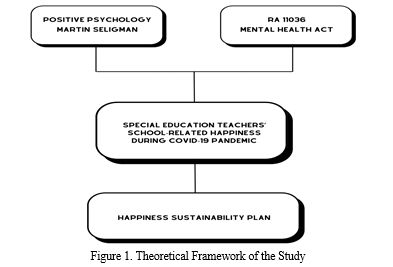
Happiness is undeniably a fundamental human drive that people constantly pursue in various ways, as revealed in numerous studies. One development in happiness studies developed by Martin Seligman (2002) focuses on positive psychology. Psychology in general investigates not just one's disease, weakness, and damage but also one's strength and virtue. Positive psychology shifts its compass from fixing life's negative aspects to fostering positive ones, which is helpful to coaching, teaching, relationships, the workplace, and other life domains. This kind of psychology teaches Special Education Teachers how to harness the power of perspective shifts to maximize the potential for happiness in their daily activities in dealing with their environment, co-workers, and school administrators aside from their learners with educational needs they nurture.
The Mental Health Act of 2018, known as RA 11036, may guide in the happiness sustainability plan creation to sustain Special Educational Teachers’ happiness. Under its provision under Chapter V, Sections 24 and 25 on Education, Promotion of Mental Health in Educational Institutions and in the Workplace states that a workplace must develop policies and programs for educators to raise awareness on mental health issues, identify and provide support and services for individuals at risk, and provide facility access, including referral mechanisms, for individuals with mental health conditions to treatment and psychosocial support. Employers must also embrace mental health policies and initiatives, eliminate stigma and discrimination, and connect individuals with mental health issues to treatment and psychological support.
The current pandemic and social restrictions make it harder for Special Education Teachers to adapt to the situation, as relationships with other people areessential to life. Through this law, concerned professionals in institutions should seek to include mental health in the education system by promoting related programs to develop growth and development among teachers. Hence, the Mental Health Act becomes the legal basis of this study to propose a happiness sustainability plan among Special Education Teachers.
B. The Problem
- Statement of the Problem
This research assessed the level of school-related happiness of Special Education teachers and their strategies to sustain happiness at the Cebu Technological University in Cebu for the school year 2021-2022 as basis for propose Happiness Sustainability Plans.
Specifically, the study sought to answer the following specific problems.
a. What is the profile of the respondents in terms of:
1.1 age and gender,
1.2 civil status,
1.3 academic rank, and
1.4 length of service?
b. What is the level of school-related happiness of the respondents in terms of:
2.1 physical equipment,
2.2 collaboration, and
2.3 school management?
c. Is there a significant relationship between the profile and the level of happiness of the respondents?
d. What strategies are employed by the respondents to sustain their school-related happiness?
e. Based on the findings, what Happiness Sustainability Plans can be crafted?
???????2. Null Hypothesis
Based on the objectives of the study, the following null hypothesis will be tested at 0.05 level of significance.
Ho: There is no significant relationship between the profile and the level of school-related happiness of the respondents.
3. Significance of the Study
The results of the study will benefit the following:
- Department of Education: Results of empirical studies on happiness particularly of the Special Education Teachers and their well-being can provide relevant inputs in the formulation and implementation of welfare-enhancing policies and public programs by the Department of Education.
- Department of Health: Because of the continuing mental health impacts of the COVID-19 pandemic and other stressors such as financial problems and relationship problems, the outcomes of this study will serve as a basis for intensifying community mindfulness across the country, especially in the implementation of RA 11036 or the Mental Health Act.
- School Administrators: The school administrators will balance their priorities, taking into account the well-being of their teachers by exhibiting good leadership through having physical structures and programs that would help the teachers sustain happiness even in times of adversity.
- Educators: This study will help educators awaken to the essence of life – happiness and will engage in self-help activities to promote well-being.
- School Psychologists and Guidance Counselors: The outcome of this study will be the basis for the School Psychologists and Guidance Counselors in giving interventions to the teachers, especially Special Education Teachers.
- Community: Knowing the adverse effects of the COVID-19 pandemic on the general public, the impact of the economic crisis, and the family problems it entails, the results of this study will help raise community awareness on coping with their life situation and finding true happiness in this time of adversity.
- Researchers: This study will help the researchers to be aware of the grounds of school-related happiness and so will become an example of a fulfilled and happy special educator.
- Future Researchers: The outcome of this study would serve as a springboard for accomplishing another research endeavor.
C. Research Methodology
This section presents the research design, the research flow, the research environment, the respondents or subjects of the study, the instruments to be used, the data gathering procedures, the statistical treatment of data to be employed, and the scoring procedure.
- Design
According to (Richard & Margaret, 1990: 125), universal sampling refers to the selection of sample when not all persons in the population have the same profitability of being included in the model and each one of them, the chance of being picked is unknown.
The researcher selected universal sampling to choose participants who currently taking up their master’s degree in Cebu Technological University since they may supply relevant information to test the study hypothesis. A descriptive-correlational research approach was employed for the quantitative portion of the study. A descriptive-correlational study design, according to Quaranta (2017), defines a phenomenon, its characteristics, and the links between them. In this section, the quantitative data identified the various levels of school-related happiness of the participants in terms of physical equipment, collaboration, and school management and the significant relationship between the profile and the level of happiness. The quantitative data were collected with participants’ responses generated through a google form link provided to them. They also offered their personal strategies in order to maintain happiness in the school environment. The quantitative data gathered identified the different happiness levels among these Special Education Teachers.
2. Flow of the Study
The study follows the Input-Process-Output [IPO] continuum. This flow serves as the structure and guidance for the direction of the study. The inputs of this study include the demographic profile, the levels of happiness, and the challenges encountered by Special Education Teachers taking up their master’s degree at Cebu Technological University. These inputs obtained using a three-part survey questionnaire and a two-part interview protocol.
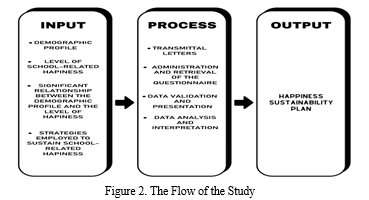
The process of this study includes the administration and retrieval of the survey questionnaire and the administration of interviews. It also covers the validation, presentation, analysis, and interpretation of data.
The outputs of this study include recommendations and measures put forward to the Superintendent of the Lapu-Lapu City Division for possible adoption and implementation.
3. Environment
Cebu Technological University is a public, non-sectarian, coeducational state-funded higher education institution situated at Corner M.J. Cuenco Ave. & R. Palma St., Cebu City, Philippines.
The researchers aim to gather quantitative data from 45 Special Education Teachers using a complete enumeration. On the other hand, the researchers aim to collect qualitative data from these participants until data saturation is reached. The study conducted from April 2022 to May 2022 to Special Education Teachers currently taking their master’s degree at Cebu Technological University from Cebu City Division, Cebu Province Division, and from other Divisions for School Year 2021-2022.
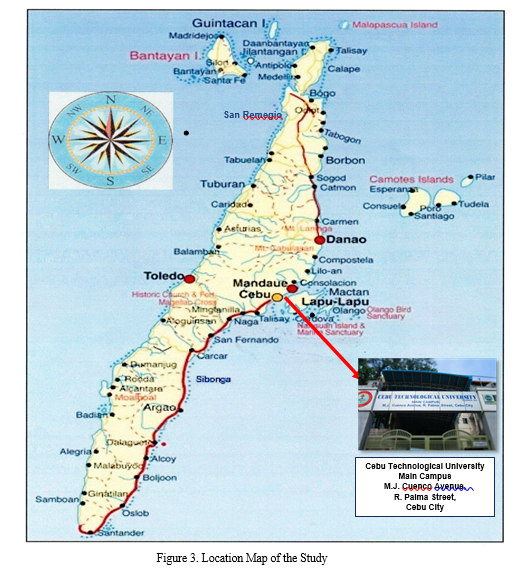
4. Respondents
The research respondents are 45 Special Education Teachers from Cebu Ce with 16, Cebu Province with 13, and from Other Identified Divisions with 16 respondents who are currently taking up their master’s degree at Cebu Technological University.
The researchers chose these Special Education Teachers as participants because like them they are currently enhancing their professional development in this institution. Moreso, they are one of the many teachers who are experiencing the greatest demand for work and battling the effects of the pandemic regarding their school-related activities since they are dealing with learners with special educational needs.
Table 1 shows the distribution of the research respondents.
|
Table 1 Distribution of the Respondents |
||
|
School Divisions |
N |
% |
|
Cebu City |
16 |
35.56 |
|
Cebu Province |
13 |
28.89 |
|
Other Identified Divisions |
16 |
35.56 |
|
Total |
45 |
100.00 |
5. Instrument
The quantitative data gathered in the student joined the participants to answer a three-part data gathering tool, which included the Consent Form, the Demographic Profile, the School Happiness Scale using Likert scale adapted from the Eurasian Journal of Educational Research’s School Happiness: A Scale Development and Implementation Study by Senol Sezer and Ertug Can.
The School Happiness Scale adapted from the Eurasian Journal of Educational Research’s School Happiness: A Scale Development and Implementation Study by Senol Sezer and Ertug Can underwent a careful procedure. It started with creating an item pool where 20 teachers were asked about the standards for school happiness and then analyzed using the content analysis technique, which determined the basic standards for school happiness. Scale items were rewritten after experts' opinions were consulted to determine the suitability level of each item to measure teachers' school happiness.
The validity and reliability of the School Happiness Scale (SHS) were tested and applied to 484 teachers working in different schools to determine their school happiness level. The results revealed that the scale could be applied to different participants. So, the school happiness levels of the teachers and the validity and reliability scores can be measured. Consequently, item analysis and explanatory factor analysis were carried out in the context of validity and reliability studies based on the data.
Consent Form. The first section of the data-gathering tool is reflected in the google form's front page (See Appendix B). It provides a background on who the researcher is and the purpose of the study and asks the respondents if they want to participate in the study voluntarily. It also explains the significance of the results of the study.
Demographic Profile. The demographic profile is on the second section of the data-gathering tool (See Appendix B, Part I). It gathered information about the respondents, such as age, gender, civil status, years of experience, and school type. This section of the data gathering tool answers specific problem number one.
A School Happiness Scale was answered by the respondents (See Appendix B, Part II). This instrument measures the levels of happiness of Special Education Teachers.
6. Data Gathering
The researchers submitted a Letter of Intent (See Appendix A) to allow them to administer their data-gathering tool to the teachers. The data gathering was conducted online (Google Form) due to the restrictions brought about by the pandemic. When the request is approved, the researchers will then administer survey questionnaires.
Before administering the data-gathering tool, the researchers established rapport through a brief personal introduction and a statement of the purpose of the research and the nature of the respondents' participation online.
The respondents were allowed to take their time to complete the survey. The researchers gave specific instructions for each part, asked them for their honesty in answering the items, and assured them of the confidentiality of the data collected.
Respondents were allowed to give feedback about the survey items during the administration of the survey and enquire about it or seek clarification from the researchers.
Following the administration of the survey questionnaire, respondents gave informal written gratitude notes and assured of receiving the research results. Once the data collection tools were complete, data ran through and analyzed through statistics.
7. Ethical Considerations
A consent form for participation in the survey was given to the respondents to secure the confidentiality of their responses when it comes to data gathering and procedures as a participant in this research study. The consent assured that their involvement in the research project is entirely voluntary.
8. Statistical Treatment
For the quantitative aspect, descriptive and inferential statistics were used to aid in the analysis and interpretation of the data gathered. Computations were performed using appropriate software, particularly Microsoft Excel 2013 and SPSS Version 19.
For the first problem, which seeks to identify the respondents’ demographic profile, frequency counts, means, and percentages computed. Frequency counts refer to the number of times a particular unit, event, behavior, or response occurs in a specific time. Means refer to the average of a particular set of numbers. Percentages are the rate or proportion of a specific set of numbers expressed as a fraction of 100.
For the second problem, which is intended to understand the relationship between the demographic profile and their level of happiness, a chi-square test used. A chi-square test is a statistical test that measures the relationship between ordinal and nominal variables.
For the third problem, which intends to analyze the level of happiness of the SPED Teachers, an adapted instrument from the “School Happiness: A Scale Development and Implementation Study” by Senol Sezer and Ertug Can be used.
For the fourth problem, aimed to investigate developing a “Happiness Sustainability Plan” that sustain the happiness of the SPED Teachers.
9. Scoring Procedure
The data obtained through the survey questionnaire is scored and described according to the following.
School-Related Happiness Scale. The respondents were asked to answer the items using a four-point scale ranging from 1 (Not Happy) to 4 (Extremely Happy). Specifically, responses from the items scored, as shown below.
Table 2
Scoring Procedure for the Level of School-RelatedHappiness of the Participants
|
Scale |
Numerical Rating |
Descriptive Rating |
Verbal Interpretation |
|
4 |
3.25-4.00 |
Extremely Happy |
The respondents strongly agree with statements describing their school-related happiness. |
|
3 |
2.50-3.24 |
Happy |
The respondents agree with statements describing their school-related happiness. |
|
2 |
1.75-2.49 |
Somewhat Happy |
The respondents disagree with statements describing their school-related happiness. |
|
1 |
1.00-1.74 |
Not Happy |
The respondents strongly disagree with statements describing their school-related happiness. |
D. Definition Of Terms
Operational definitions are herein provided to ensure a firm grasp of the essential terms utilized throughout the study.
Enlightened. This is to differentiate from the commonly used word, “Self-Discovery”. In truth, there is nothing to discover. The SELF has always been there, properly called BEING. And the nature of this BEING is HAPPINESS. Hence, happiness is not discovered nor a choice. It is innate.
Enlightened Model of Happiness Program. It is a 54-hour workshop-seminar using the perspective of the Enlightened Model of Happiness (Chopra and Tanzi. 2012)
Happiness. From the medical perspective, happiness is the state of mind in which our thinking is pleasant, a good share of the time (Maltz, Maxwell. The New Psycho-cybernetics. p.117). From the perspective of the perennial philosophy, happiness is a state of being filled with whatever occurs in life. Therefore, happiness is found in being fully present in the moment, without conditions (Fors, Greg. Why We Hurt. p. 370). Happiness is living in the now (Tolle, Eckhart. The Power of Now. 2004). Happiness is our natural state (Stroud, J. Francis Awareness: The Perils and Opportunities of Reality. New York: Doubleday 1992, p.38)
Happiness Sustainability Plan. The sustainability plan consists of programs, activities, and exercises designed to help the participants recover HAPPINESS which is their essence.
School-related Happiness. It is the emotional well-being that results when school expectations and the personal needs of teachers, school management, and other personnel are in accord.
Special Education Teacher. A Special Education Teacher is in charge of giving appropriate lessons and assistance to students with special needs. Students with special needs have different difficulties, may they be intellectual, emotional, physical, or behavioral. This special teaching job needs a “happy being”.
Sustained Happiness. From the Enlightened Brain’s perspective, it is the realization that one is a complete life, not a half-life. The awareness that one is in essence, HAPPINESS (Chopra and Tanzi. 2012)
II. PRESENTATION, ANALYSIS, AND INTERPRETATION OF DATA
This chapter presents the analyses and interpretations of the data gathered from the study which aimed to determine the profile of the respondents in terms of their age, gender, civil status, academic rank and their length of service. This also assesses the level of school-related happiness of the respondents in terms of physical equipment, collaboration, and school management. Furthermore, the relationship of the respondents’ profile and their school-related happiness in terms of physical equipment, collaboration and school management were also considered. With the help of the respondents’ answers to the survey questionnaire, the following results and findings are hereby presented and discussed as follows:
A. Results From Cebu City Division
This portion presents the data gathered from the identified schools in Cebu City Division. Below are the results of the data gathered and treated based on the objectives of the study.
B. Profile of The Respondents
This section presents the profile of the respondents in terms of their age, gender, civil status, academic rank and their length of service. These variables are important in the development of the study because these provide information about the background of the respondents.

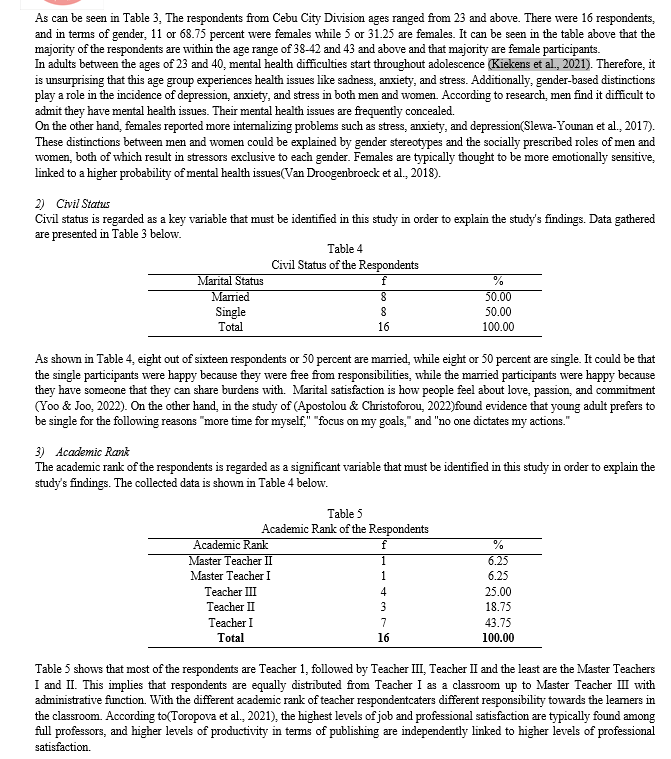
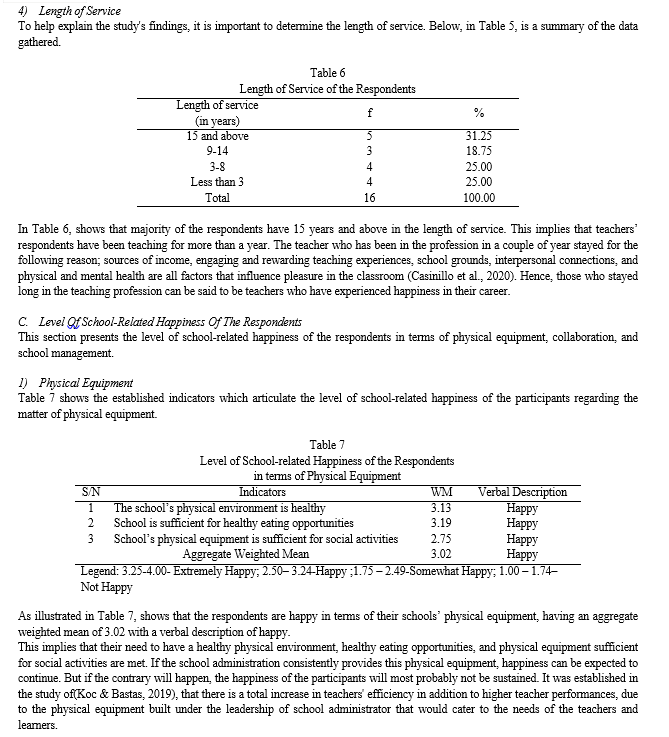

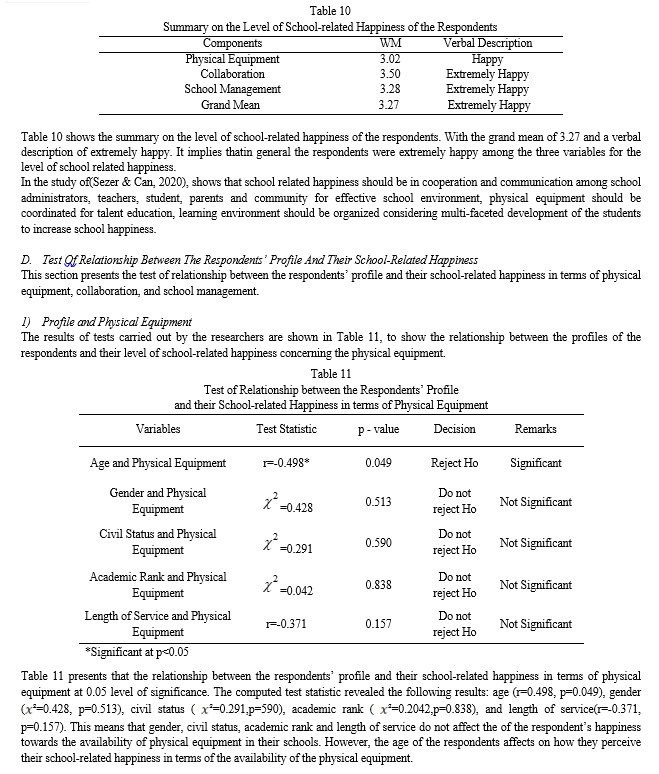
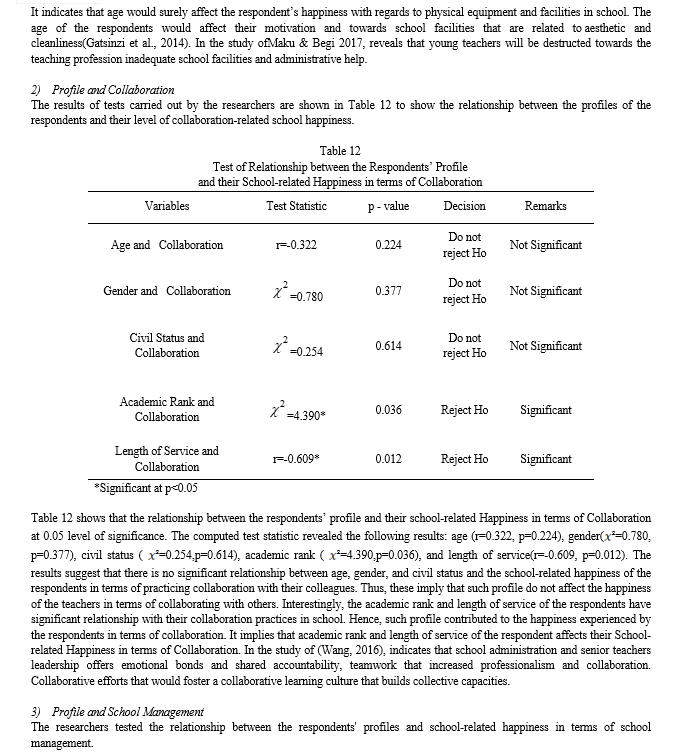
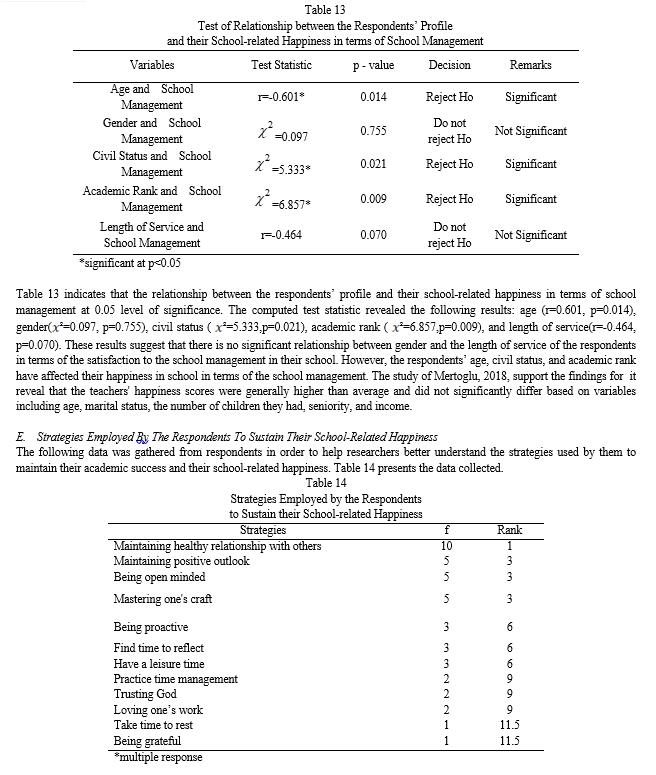
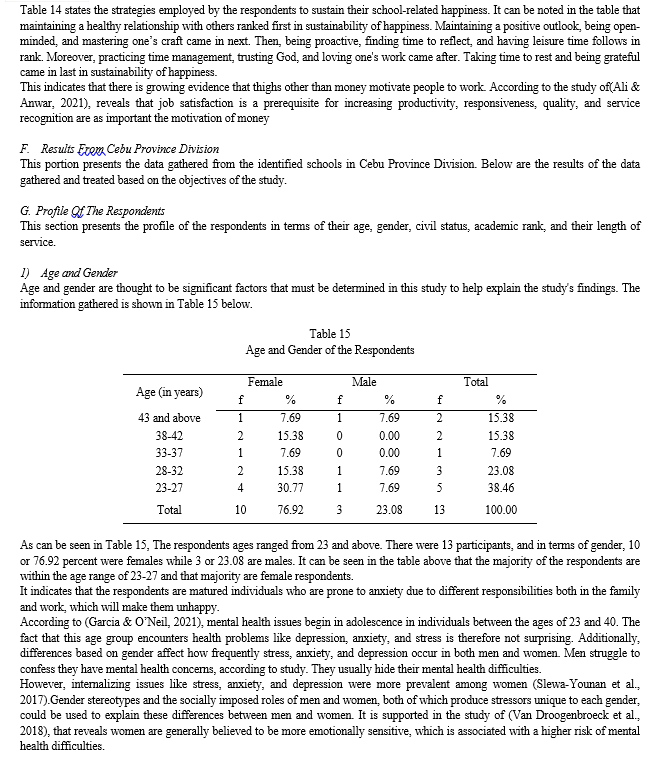
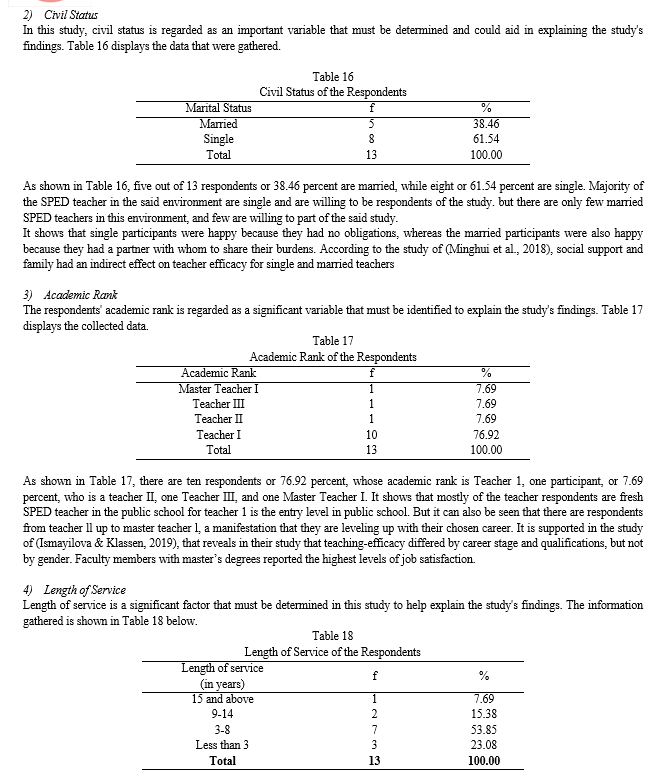
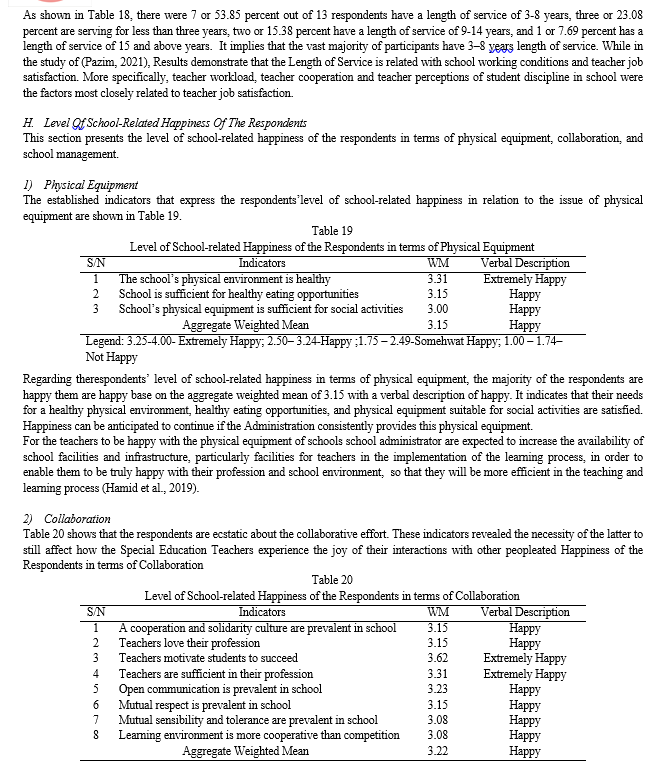
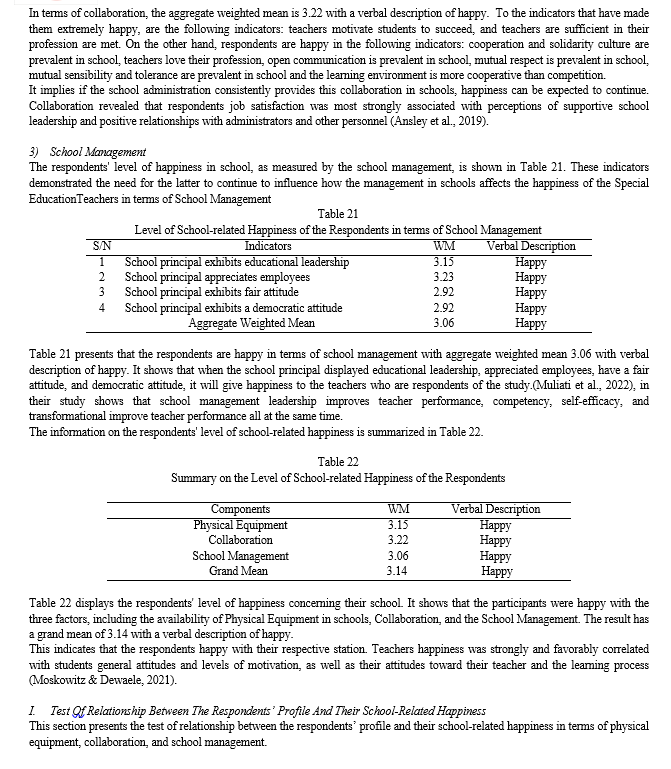

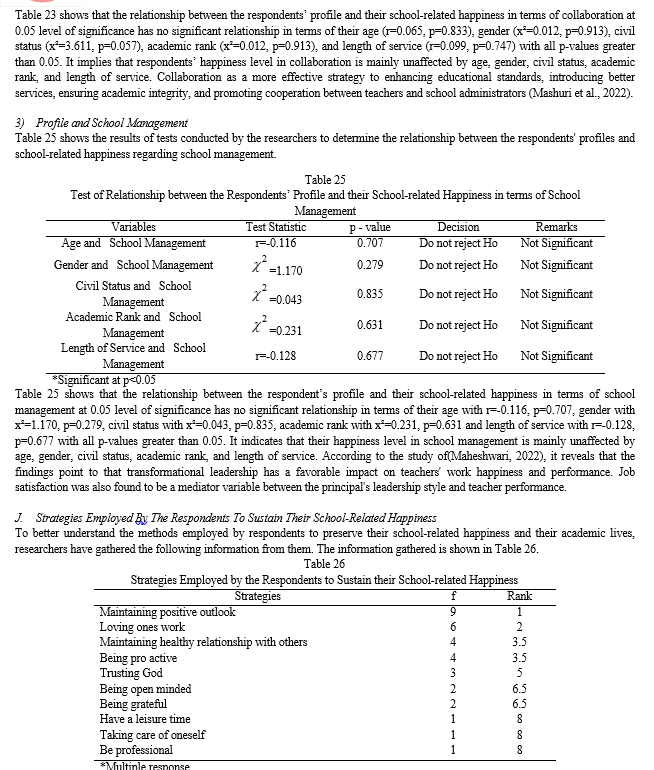

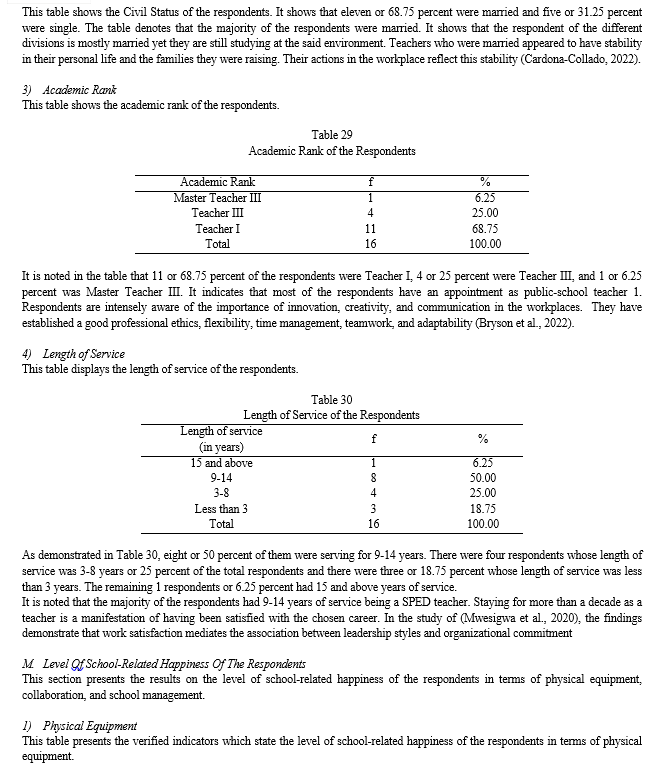
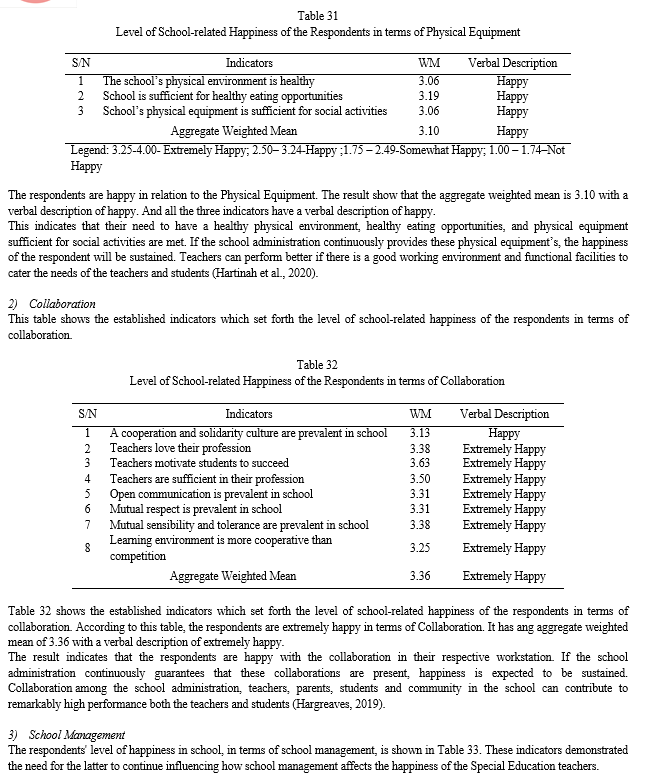
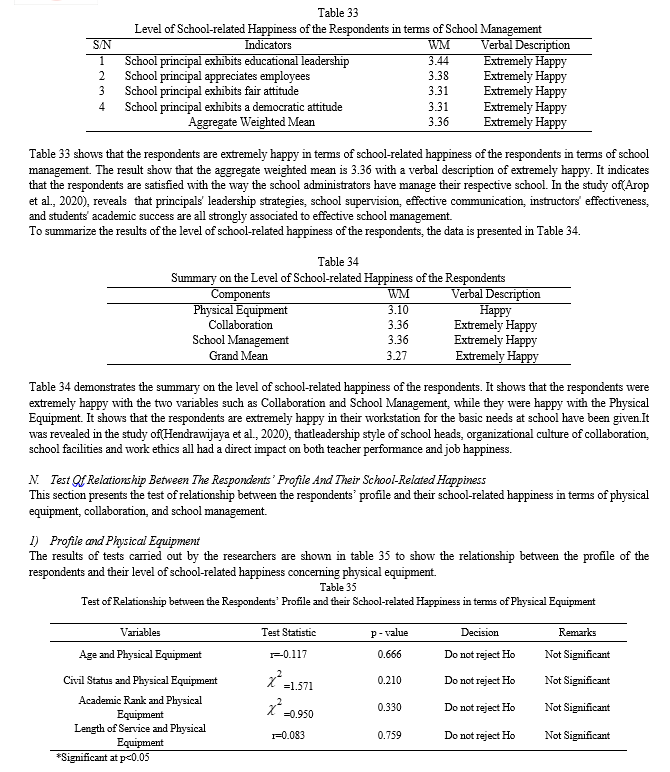


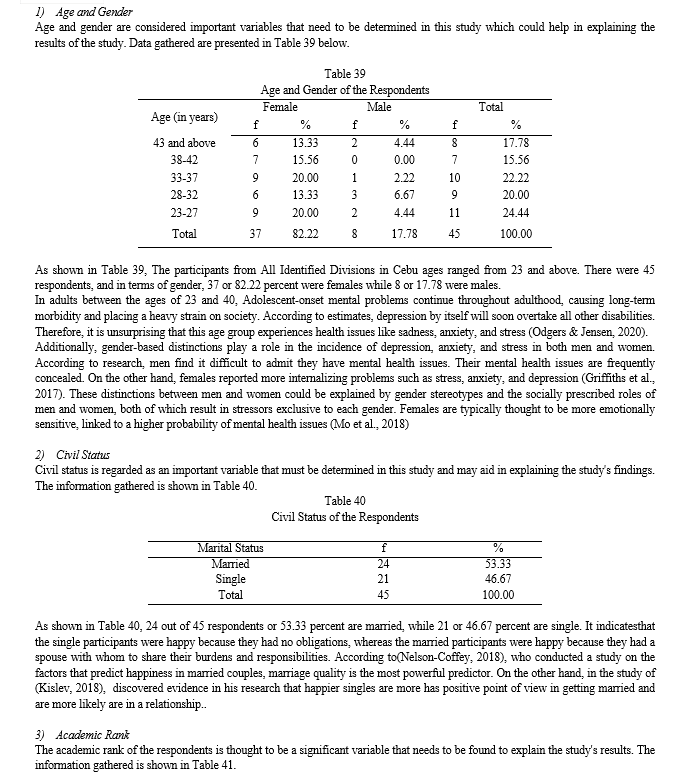
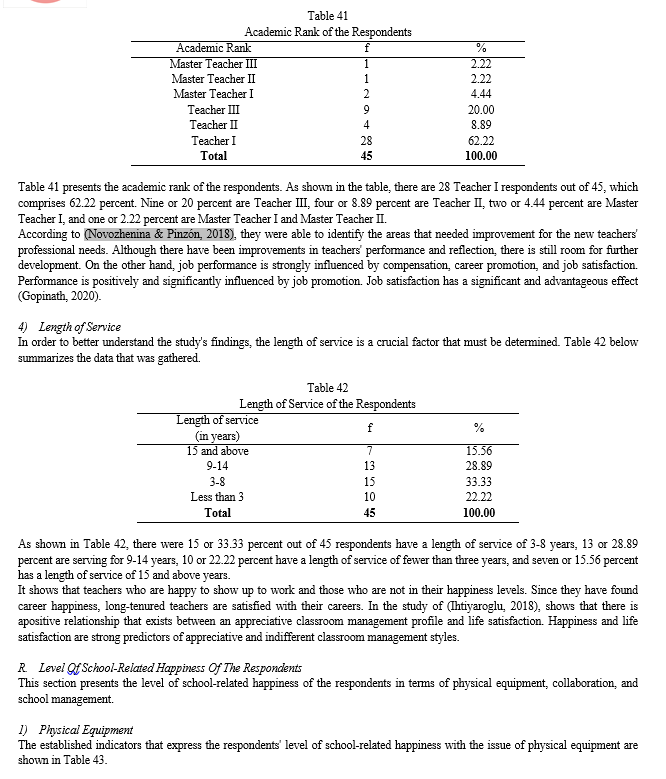
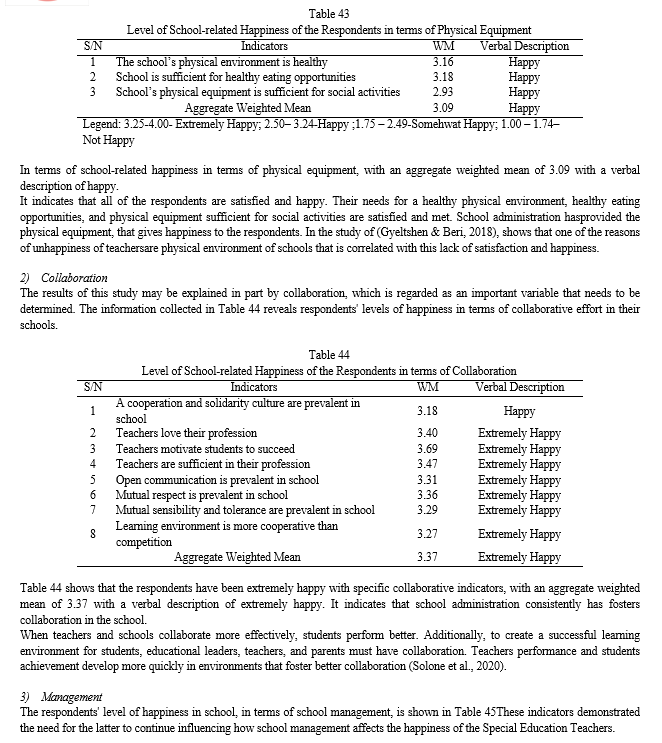

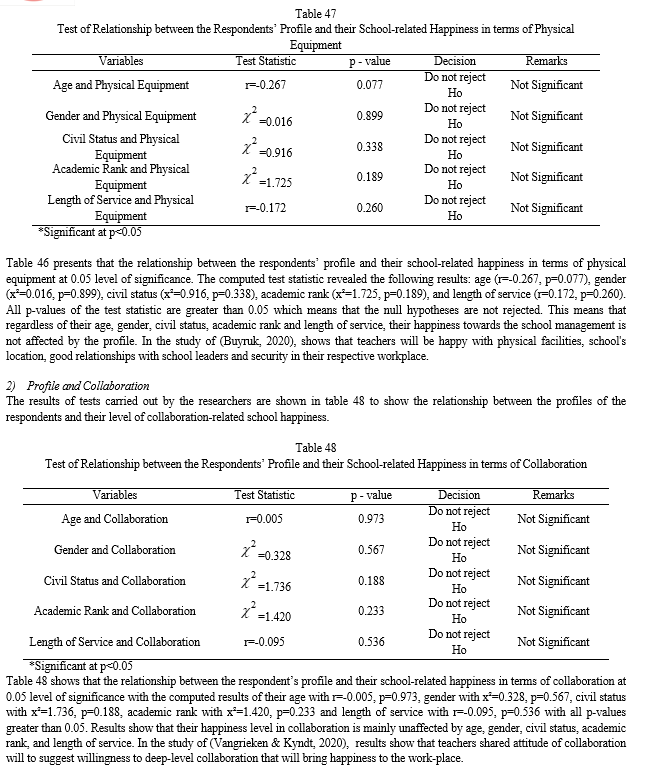
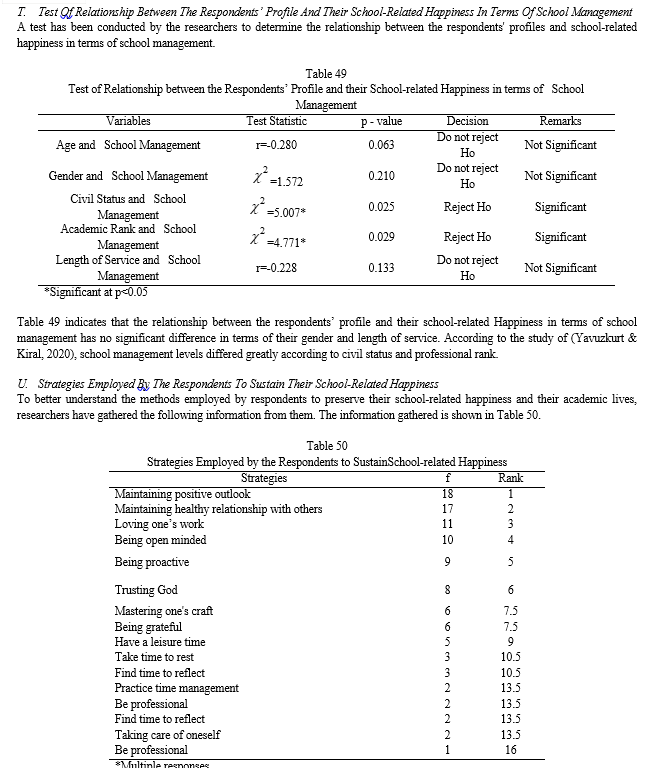
Table 50 shows the methods and strategies employed by respondents to sustain their happiness in their workplace. According to the table, keeping a positive outlook is the most essential strategy for SpEd teachers to sustain their happiness at work.
Following that came the importance of maintaining a healthy relationship with others and loving one's work. Next in rank are being open-minded, being proactive, trusting God, mastering one's craft, being grateful, having leisure time, taking time to rest, and finding time to reflect. Practicing time management, being professional, finding time to reflect, and taking care of oneself came next. Moreover, being professional ranked last in terms of sustaining the school-related happiness of Special Education Teachers. According to the research of(Kun & Gadanecz, 2022), the primary pillars of teachers' workplace happiness were maintaining positive outlook, goal accomplishment, feedback, finding significance in work, and social ties.
III. THE OUTPUT OF THE STUDY
The sustainability plan consists of programs, activities, and exercises designed to help the Sped-Teachers recover HAPPINESS which is their essence.
A. Rationale
The plan is designed to provide practical and actionable insights so the Sped-Teachers can fully recover their nature which is HAPPINESS.
B. Description
The entire plan is anchored on Buuttherapy: Unveiling the Happiness Within by Dr. Vicente J. Igot. It is a 56-hour experiential process of unveiling BUUT as the true SELF whose essence is HAPPINESS.
C. Objectives
This happiness sustainability plan aims to:
- Awaken the Sped-Teachers from the ignorance of what they are not so that they will stop behaving what they are not that resulted to unhappiness.
- Enlighten them to what they really are in order to recover their true SELF which is happiness by essence.
- Provide them necessary structures such as small community of Teachers with regular schedule of recollection/retreat and weekly meeting/fellowship.
D. Scheme of Implementation
For review and approval, this happiness sustainability plan will be forwarded to the approving body of the school. As soon as the approval has been obtained, preparation will begin while observing all school-related policies. Specifically, preparation will entail coordination with concerned parties, invitation of resource speakers, campus-wide dissemination of the upcoming activities, and preparation of other technical aspects involved in facilitating the happiness sustainability plan.
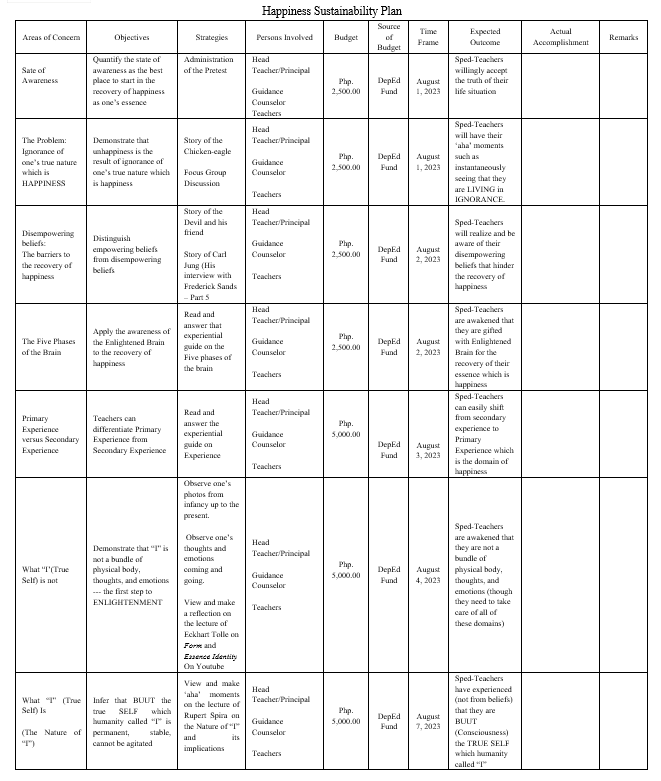
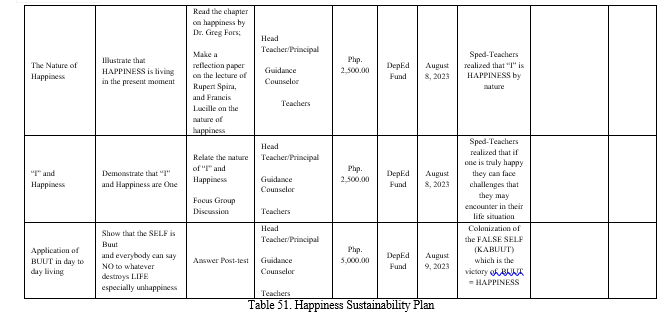
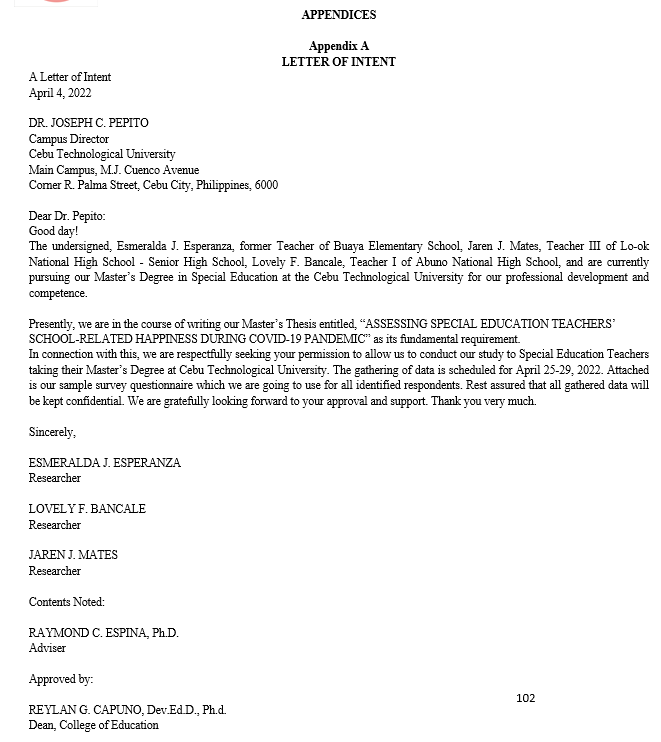
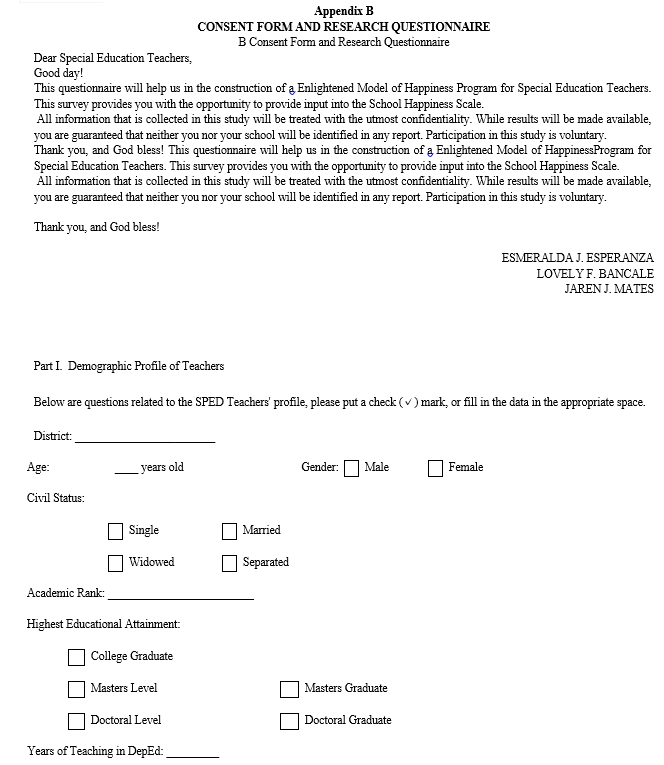
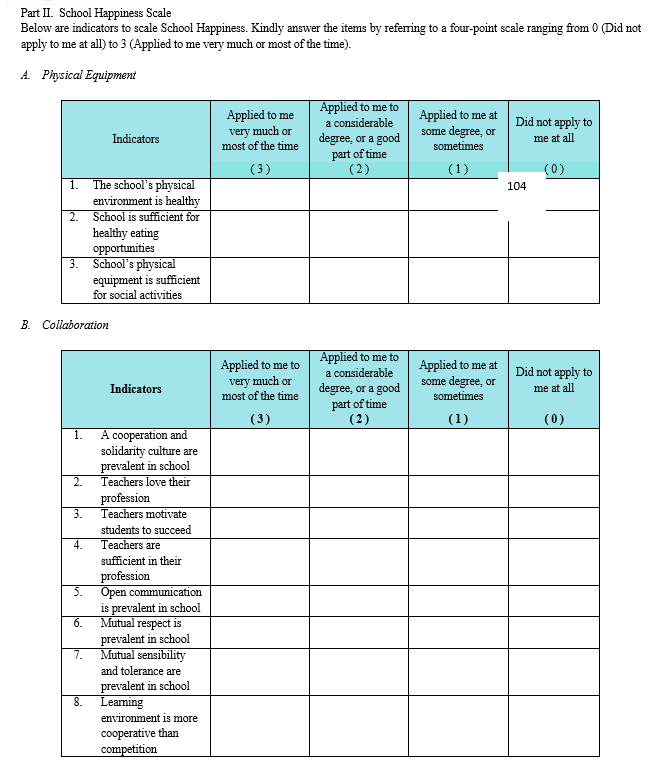
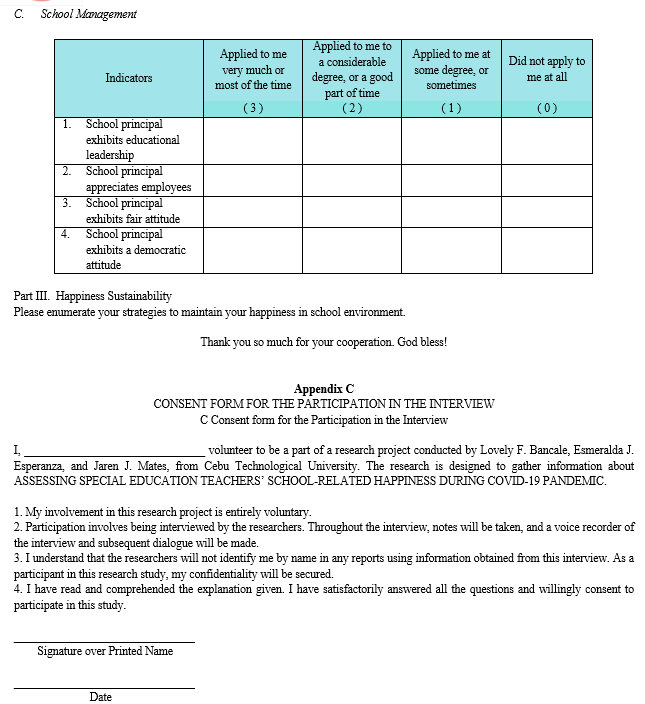
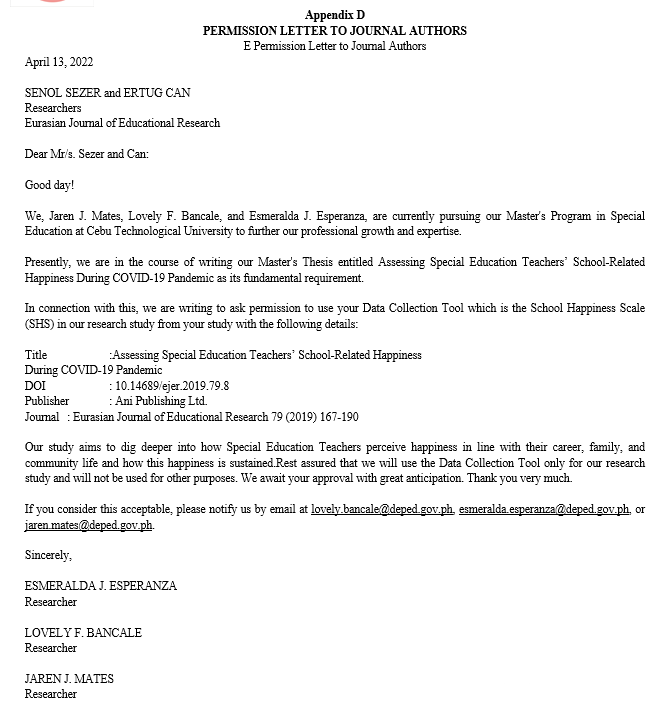
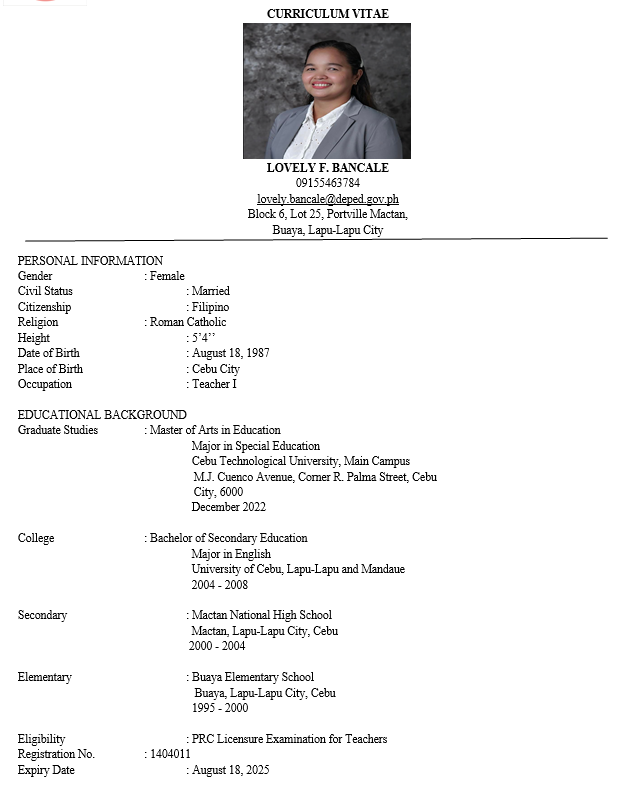
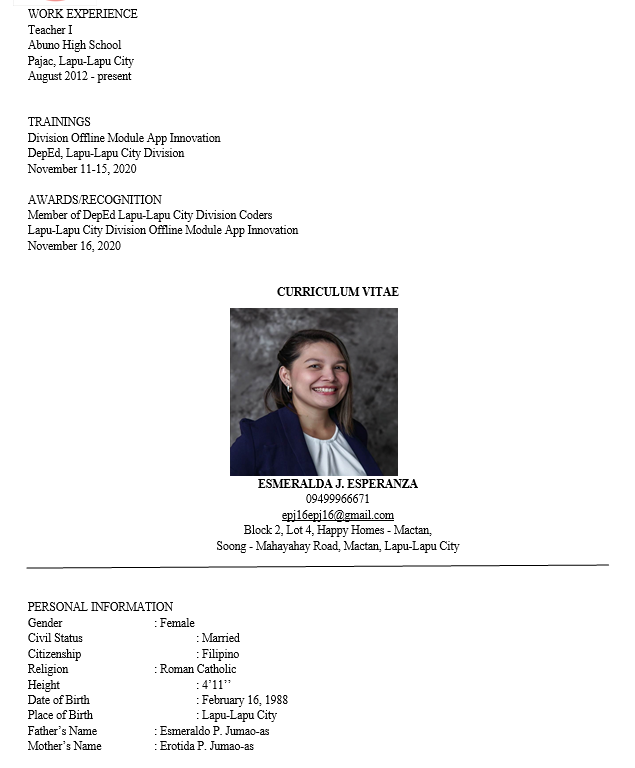
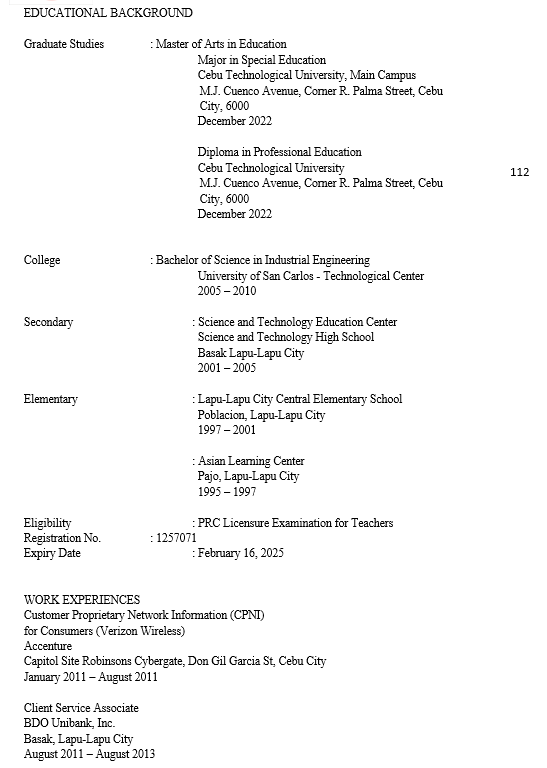
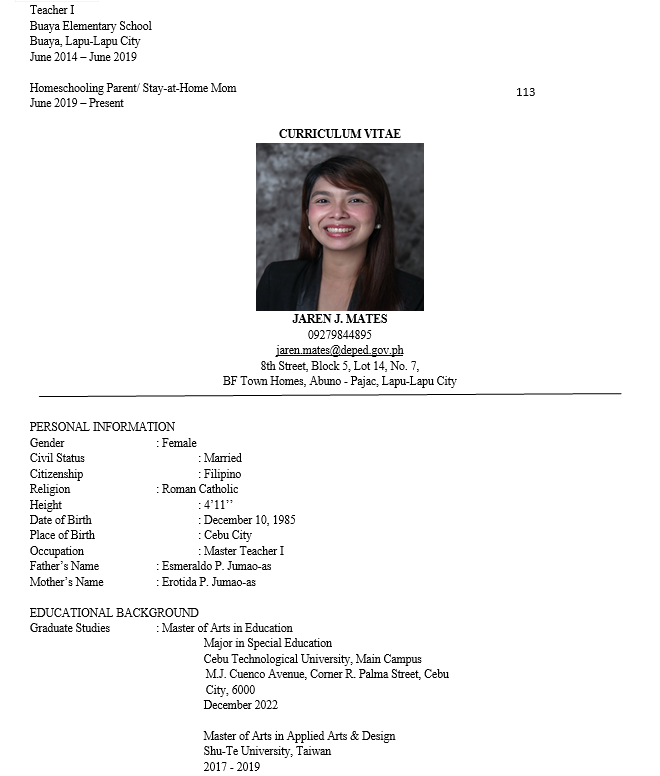

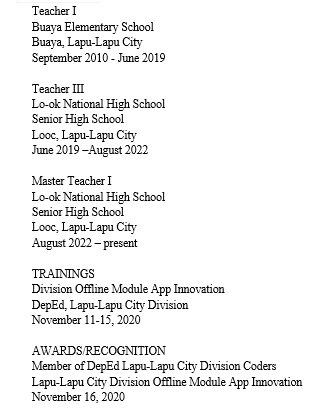
Conclusion
This chapter presents the integral parts of the research. It summarizes the study, reveals the findings based on statistical analysis and arrived impartial conclusions. Furthermore, the researcher provides certain recommendations for the utilization of the research findings and suggestions for future related studies. A. Summary The research assessed the special education teachers’ school-related happiness during covid-19 pandemic at state university in Cebu province school year 2022-2023 as basis for happiness sustainability plans. Specifically, vital questions were answered relative to the study such as the students’ demographic profile, level of school-related happiness and significant relationship between the profile, the level of happiness of the respondents. Furthermore, the study assessed the strategies employed by the respondents to sustain their school-related happiness. Wherein, based on the findings, a happiness sustainability plan was created for the purpose of sustaining the happiness of the teachers. The researcher used a quantitative descriptive-correlation research design and data were gathered through an adapted questionnaire. This study addressed the significant relationship between the profile and the level of happiness of the respondents in terms of physical equipment, collaboration, school management and strategies employed by the respondents to sustain their school-related happiness. B. Findings Based on the collected, organized, presented, and statistically analyzed and interpreted data, the following significant findings are revealed that ages of respondents ranged from 23 and above. There were 45 respondents, and in terms of gender, 37 or 82.22 percent were females while 8 or 17.78 were males. In addition,24 out of 45 respondents or 53.33 percent are married, while 21 or 46.67 percent are single. For the academic rank of the respondents there are 28 Teacher I respondents out of 45, which comprises 62.22 percent. Nine or 20 percent are Teacher III, four or 8.89 percent are Teacher II, two or 4.44 percent are Master Teacher I, and one or 2.22 percent are Master Teacher I and Master Teacher II. For the length of service of the respondents there were 15 or 33.33 percent out of 45 respondents have a length of service of 3-8 years, 13 or 28.89 percent are serving for 9-14 years, 10 or 22.22 percent have a length of service of fewer than three years, and seven or 15.56 percent has a length of service of 15 and above years. On the other hand, measurement of significant relationship between the profile and the level of happiness of the respondents. In terms of school-related happiness in terms of physical equipment, it has an aggregate weighted mean of 3.09 with a verbal description of happy. For school-related happiness in terms of collaboration, the respondents have been extremely happy with specific collaborative indicators, with an aggregate weighted mean of 3.37 with a verbal description of extremely happy. While school-related happiness levels in terms of school management. It has an aggregate weighted mean of 3.24 with a verbal description of happy. As to respondents\' level of school-related happiness. As can be seen, the participants are happy with the two components access to resources for physical equipment in schools and the school management. On the other hand, they are extremely happy with the collaborative aspect. Meanwhile, in the determination whether there is a significant relationship between the profile, the level of happiness of the respondents. For the relationship between the respondents’ profile and their school-related happiness in terms of physical equipment has no significant difference. While for the relationship between the respondents’ profile and their school-related happiness in terms of collaboration has no significant. And for the relationship between the respondents’ profile and their school-related Happiness in terms of school management has no significant difference in terms of their gender and length of service. However, the relationship between the respondents’ profile and their school-related Happiness differed significantly based on their Civil status and academic rank. For the methods and strategies employed by respondents to sustain their happiness in their workplace. Following that came the importance of maintaining a healthy relationship with others and loving one\'s work. Next in rank are being open-minded, being proactive, trusting God, mastering one\'s craft, being grateful, having leisure time, taking time to rest, and finding time to reflect. Practicing time management, being professional, finding time to reflect, and taking care of oneself came next. Moreover, being professional ranked last in terms of sustaining the school-related happiness of Special Education Teachers. C. Conclusion There are several factors associated with special education teachers’ school-related happiness during covid-19 pandemic. there are three factors that would affect special education teachers’ school-related happiness namely: physical equipment, collaboration, and school management. Like others studies (Meredith et al., 2022) this study also found a significant relationship between the profile, the level of happiness of the respondents. The profile of the respondents develops the collaborative culture, that is positively associated to school management commitment to sustain the physical equipment of the school for the happiness and job satisfaction of teachers. D. Recommendations Based on the significant findings and conclusions of the study, it is recommended that the output of the study which is happiness sustainability plans be used. For a sustainable happiness in the school environment.
References
[1] Ansley, B. M., Houchins, D., & Varjas, K. (2019). Cultivating Positive Work Contexts That Promote Teacher Job Satisfaction and Retention in High-Need Schools. Journal of Special Education Leadership, 32(1), 3–16. [2] Apostolou, M., & Christoforou, C. (2022). What Makes Single Life Attractive: An Explorative Examination of the Advantages of Singlehood. Evolutionary Psychological Science, 8(4), 403–412. https://doi.org/10.1007/s40806-022-00340-1 [3] Aramo-Immonen, H. (2011). Mixed methods research design. World Summit on Knowledge Society, 32–43. [4] Arias Gallegos, W. L., Huamani Cahua, J. C., & Ceballos Canaza, K. D. (2019). Burnout Syndrome in School Teachers and University Professors: A Psychometrical and Comparative Analysis from Arequipa City. Journal of Educational Psychology - Propositos y Representaciones, 7(3), 92–113. [5] Arias-Reyes, C., Carvajal-Rodriguez, F., Poma-Machicao, L., Aliaga-Raduán, F., Marques, D. A., Zubieta-DeUrioste, N., Accinelli, R. A., Schneider-Gasser, E. M., Zubieta-Calleja, G., Dutschmann, M., & Soliz, J. (2021). Decreased incidence, virus transmission capacity, and severity of COVID-19 at altitude on the American continent. PLOS ONE, 16(3), e0237294. https://doi.org/10.1371/journal.pone.0237294 [6] Arop, F. O., Mbon, U. F., Ekanem, E. E., & Ukpabio, G. E. (2020). School Management Practices, Teachers Effectiveness, and Students’ Academic Performance in Mathematics in Secondary Schools of Cross River State, Nigeria. Humanities and Social Sciences Letters, 8(3), Article 3. https://doi.org/10.18488/journal.73.2020.83.298.309 [7] Bayraktar, H. V., & Girgin, S. (2020). The Examination of Teachers’ Levels of Organizational Happiness. Journal of Education and Learning, 9(5), 170–183. [8] Benevene, P., De Stasio, S., Fiorilli, C., Buonomo, I., Ragni, B., Briegas, J. J. M., & Barni, D. (2019). Effect of Teachers’ Happiness on Teachers’ Health. The Mediating Role of Happiness at Work. Frontiers in Psychology, 10. https://www.frontiersin.org/articles/10.3389/fpsyg.2019.02449 [9] Bryson, A., Corsini, L., & Martelli, I. (2022). Teacher allocation and school performance in Italy. Labour, 36(4), 409–423. [10] Buyruk, H. (2020). A School Choice Experience at the Age of “Parentocracy”: Impressions from a Public Primary School in Turkey. International Journal of Progressive Education, 16(2), 230–247. [11] Calp, ?. (2020). Peaceful and Happy Schools: How to Build Positive Learning Environments? International Electronic Journal of Elementary Education, 12(4), 311–320. [12] Cardona-Collado, J. A. (2022). Pedagogical Competence of Elementary Central School Teachers in Implementing the Blended Instruction Approach (Bia). 8. [13] Carty, A., & Marie Farrell, A. (2018). Co-teaching in a mainstream post-primary mathematics classroom: An evaluation of models of co-teaching from the perspective of the teachers. Support for Learning, 33(2), 101–121. [14] Casinillo, L. F., Casinillo, E. L., & Casinillo, M. F. (2020). On Happiness in Teaching: An Ordered Logit Modeling Approach. JPI (Jurnal Pendidikan Indonesia), 9(2), Article 2. https://doi.org/10.23887/jpi-undiksha.v9i2.25630 [15] Chang, K., & Kuhlman, K. R. (2022). Adolescent-onset depression is associated with altered social functioning into middle adulthood. Scientific Reports, 12(1), Article 1. https://doi.org/10.1038/s41598-022-22131-1 [16] Chopra, D., & Tanzi, R. E. (2016). Super-Brain: Angewandte Neurowissenschaften gegen Alzheimer, Depression, Übergewicht und Angst. Langen Mueller Herbig. [17] Daniel, S. J. (2020). Education and the COVID-19 pandemic. Prospects, 49(1), 91–96. [18] Fors, G. (2007). Why we hurt: A complete physical & spiritual guide to healing your chronic pain. Llewellyn Worldwide. [19] Garcia, I., & O’Neil, J. (2021). Anxiety in Adolescents. The Journal for Nurse Practitioners, 17(1), 49–53. https://doi.org/10.1016/j.nurpra.2020.08.021 [20] Gatsinzi, P., Role, J., & Ndiku Makewa, L. (2014). Work and School Related Variables in Teacher Motivation in Gasabo District, Rwanda. Journal of Education and Training, 1, 262–275. https://doi.org/10.5296/jet.v1i2.4747 [21] Griffiths, S., Murray, S. B., Bentley, C., Gratwick-Sarll, K., Harrison, C., & Mond, J. M. (2017). Sex Differences in Quality of Life Impairment Associated With Body Dissatisfaction in Adolescents. Journal of Adolescent Health, 61(1), 77–82. https://doi.org/10.1016/j.jadohealth.2017.01.016 [22] Grinnell, R. M., & Williams, M. (1990). Research in social work: A primer. Wadsworth. [23] Gyeltshen, C., & Beri, N. (2018). Work Place Happiness: A Tool for Teacher Effectiveness. Indian Journal of Public Health Research & Development, 9(12). [24] Hamid, P. A., Suriansyah, A., & Ngadimun, N. (2019). The Relationship between Interpersonal and Emotional Intelligence on Teacher Performance. Journal of K6 Education and Management, 2(1), Article 1. https://doi.org/10.11594/jk6em.02.01.10 [25] Hargreaves, A. (2019). Teacher collaboration: 30 years of research on its nature, forms, limitations, and effects. Teachers and Teaching, 25(5), 603–621. [26] Hartinah, S., Suharso, P., Umam, R., Syazali, M., Lestari, B., Roslina, R., & Jermsittiparsert, K. (2020). Retracted:Teacher’s performance management: The role of principal’s leadership, work environment and motivation in Tegal City, Indonesia. Management Science Letters, 10(1), 235–246. [27] Hendrawijaya, A. T., Hilmi, M. I., Hasan, F., Imsiyah, N., & Indrianti, D. T. (2020). Determinants of Teacher Performance with Job Satisfactions Mediation. International Journal of Instruction, 13(3), 845–860. [28] Ihtiyaroglu, N. (2018). Analyzing the Relationship between Happiness, Teachers’ Level of Satisfaction with Life and Classroom Management Profiles. Universal Journal of Educational Research, 6(10), 2227–2237. [29] Ismayilova, K., & Klassen, R. M. (2019). Research and teaching self-efficacy of university faculty: Relations with job satisfaction. International Journal of Educational Research, 98, 55–66. https://doi.org/10.1016/j.ijer.2019.08.012 [30] Kiekens, G., Robinson, K., Tatnell, R., & Kirtley, O. J. (2021). Opening the Black Box of Daily Life in Nonsuicidal Self-injury Research: With Great Opportunity Comes Great Responsibility. JMIR Mental Health, 8(11), e30915. https://doi.org/10.2196/30915 [31] Kislev, E. (2018). Happiness, post-materialist values, and the unmarried. Journal of Happiness Studies, 19(8), 2243–2265. [32] Koc, A., & Bastas, M. (2019). Project Schools as a School-Based Management Model. International Online Journal of Education and Teaching, 6(4), 923–942. [33] Komalasari, K., Arafat, Y., & Mulyadi, M. (2020). Principal’s Management Competencies in Improving the Quality of Education. Journal of Social Work and Science Education, 1(2), Article 2. https://doi.org/10.52690/jswse.v1i2.47 [34] Kun, A., & Gadanecz, P. (2022). Workplace happiness, well-being, and their relationship with psychological capital: A study of Hungarian Teachers. Current Psychology, 41(1), 185–199. https://doi.org/10.1007/s12144-019-00550-0 [35] Layous, K., & Lyubomirsky, S. (2014). The how, why, what, when, and who of happiness. Positive Emotion: Integrating the Light Sides and Dark Sides, 473–495. [36] Leung, C. H., & Pong, H. K. (2021). Cross-sectional study of the relationship between the spiritual wellbeing and psychological health among university Students. PloS One, 16(4), e0249702. [37] Maheshwari, G. (2022). Influence of Teacher-Perceived Transformational and Transactional School Leadership on Teachers’ Job Satisfaction and Performance: A Case of Vietnam. Leadership and Policy in Schools, 21(4), 876–890. https://doi.org/10.1080/15700763.2020.1866020 [38] Maku, N. G., & Begi, N. (2017). SCHOOL RELATED FACTORS CAUSING TEACHER ATTRITION IN PREPRIMARY SCHOOLS IN MOMBASA COUNTY, KENYA. European Journal of Education Studies, 0, Article 0. https://doi.org/10.46827/ejes.v0i0.891 [39] Mashuri, H. tahili, Ismail, T., Muhammad Arifin, A., Sulaiman, S., Abdul, S., & Pattaufi, P. (2022). Developing the strategic collaboration model in basic education. International Journal of Evaluation and Research in Education, 11(2), Article 2. [40] Meredith, C., Moolenaar, N., Struyve, C., Vandecandelaere, M., Gielen, S., & Kyndt, E. (2022). The importance of a collaborative culture for teachers’ job satisfaction and affective commitment. European Journal of Psychology of Education. https://doi.org/10.1007/s10212-022-00598-w [41] Mertoglu, M. (2018). Happiness Level of Teachers and Analyzing Its Relation with Some Variables. Asian Journal of Education and Training, 4(4), 396–402. [42] Minghui, L., Lei, H., Xiaomeng, C., & Potm?šilc, M. (2018). Teacher Efficacy, Work Engagement, and Social Support Among Chinese Special Education School Teachers. Frontiers in Psychology, 9. https://www.frontiersin.org/articles/10.3389/fpsyg.2018.00648 [43] Mo, P. K., Chan, V. W., Chan, S. W., & Lau, J. T. (2018). The role of social support on emotion dysregulation and Internet addiction among Chinese adolescents: A structural equation model. Addictive Behaviors, 82, 86–93. [44] Moskowitz, S., & Dewaele, J.-M. (2021). Is teacher happiness contagious? A study of the link between perceptions of language teacher happiness and student attitudes. Innovation in Language Learning and Teaching, 15(2), 117–130. https://doi.org/10.1080/17501229.2019.1707205 [45] Muliati, L., Asbari, M., Nadeak, M., Novitasari, D., & Purwanto, A. (2022). Elementary School Teachers Performance: How The Role of Transformational Leadership, Competency, and Self-Efficacy? International Journal of Social and Management Studies, 3(1), Article 1. https://doi.org/10.5555/ijosmas.v3i1.97 [46] Mwesigwa, R., Tusiime, I., & Ssekiziyivu, B. (2020). Leadership styles, job satisfaction and organizational commitment among academic staff in public universities. Journal of Management Development, 39(2), 253–268. https://doi.org/10.1108/JMD-02-2018-0055 [47] Nelson-Coffey, S. K. (2018). Married... with children: The science of well-being in marriage and family life. Handbook of Well-Being. [48] Novozhenina, A., & Pinzón, M. M. L. (2018). Impact of a Professional Development Program on EFL Teachers’ Performance. HOW Journal, 25(2), Article 2. https://doi.org/10.19183/how.25.2.406 [49] Octavia, E. T., Ismiyati, & Sholikah, M. (2020). How Do School Facilities Affect School Quality? Case Study in Vocational High School at Pati, Indonesia. KnE Social Sciences, 865–881. https://doi.org/10.18502/kss.v4i6.6648 [50] Odgers, C. L., & Jensen, M. R. (2020). Annual Research Review: Adolescent mental health in the digital age: facts, fears, and future directions. Journal of Child Psychology and Psychiatry, 61(3), 336–348. [51] Pazim, K. H. (2021). Special Education Teachers Job Satisfaction In Malaysia: A Review. Turkish Journal of Computer and Mathematics Education (TURCOMAT), 12(11), 5329–5332. [52] Roig, A. E., Mooney, O., Salamanca-Sanabria, A., Lee, C. T., Farrell, S., & Richards, D. (2020). Assessing the efficacy and acceptability of a web-based intervention for resilience among college students: Pilot randomized controlled trial. JMIR Formative Research, 4(11), e20167. [53] Sezer, S., & Can, E. (2020). School Happiness: A Grounded Theory. Educational Policy Analysis and Strategic Research, 15(1), 44–62. [54] Shorten, A., & Smith, J. (2017). Mixed methods research: Expanding the evidence base. In Evidence-based nursing (Vol. 20, Issue 3, pp. 74–75). Royal College of Nursing. [55] Slewa-Younan, S., Yaser, A., Guajardo, M. G. U., Mannan, H., Smith, C. A., & Mond, J. M. (2017). The mental health and help-seeking behaviour of resettled Afghan refugees in Australia. International Journal of Mental Health Systems, 11(1), 49. https://doi.org/10.1186/s13033-017-0157-z [56] Solone, C. J., Thornton, B. E., Chiappe, J. C., Perez, C., Rearick, M. K., & Falvey, M. A. (2020). Creating Collaborative Schools in the United States: A Review of Best Practices. International Electronic Journal of Elementary Education, 12(3), 283–292. [57] Toropova, A., Myrberg, E., & Johansson, S. (2021). Teacher job satisfaction: The importance of school working conditions and teacher characteristics. Educational Review, 73(1), 71–97. [58] Van Droogenbroeck, F., Spruyt, B., & Keppens, G. (2018). Gender differences in mental health problems among adolescents and the role of social support: Results from the Belgian health interview surveys 2008 and 2013. BMC Psychiatry, 18(1), 1–9. [59] Vangrieken, K., & Kyndt, E. (2020). The teacher as an island? A mixed method study on the relationship between autonomy and collaboration. European Journal of Psychology of Education, 35(1), 177–204. https://doi.org/10.1007/s10212-019-00420-0 [60] Velavan, T. P., & Meyer, C. G. (2020). The COVID-19 epidemic. Tropical Medicine & International Health, 25(3), 278. [61] Wang, T. (2016). School leadership and professional learning community: Case study of two senior high schools in Northeast China. Asia Pacific Journal of Education, 36(2), 202–216. https://doi.org/10.1080/02188791.2016.1148849 [62] Warnock, J. M., Gibson-Sweet, M., & van Nieuwerburgh, C. J. (2022). The perceived benefits of instructional coaching for teachers. International Journal of Mentoring and Coaching in Education, 11(3), 328–348. https://doi.org/10.1108/IJMCE-01-2021-0030 [63] Waters, L., Algoe, S. B., Dutton, J., Emmons, R., Fredrickson, B. L., Heaphy, E., Moskowitz, J. T., Neff, K., Niemiec, R., & Pury, C. (2022). Positive psychology in a pandemic: Buffering, bolstering, and building mental health. The Journal of Positive Psychology, 17(3), 303–323. [64] Widodo, S., & Manurung, L. (2022). THE EFFECT OF WORK FACILITIES AND LEADERSHIP STYLE TEACHER PERFORMANCE AT STATE 2 SMA SCHOOL BINJAI CITY. Jurnal Ekonomi, 11(01), 420–424. [65] Yavuzkurt, T., & Kiral, E. (2020). The Relationship between Workplace Friendship and Job Satisfaction in Educational Organizations. International Journal of Progressive Education, 16(5), 404–425. [66] Yoo, G., & Joo, S. (2022). Love for a Marriage Story: The Association Between Love and Marital Satisfaction in Middle Adulthood. Journal of Child and Family Studies, 31(6), 1570–1581. https://doi.org/10.1007/s10826-021-02055-6
Copyright
Copyright © 2024 Esmeralda J. Esperanza, Lovely F. Bancale, Jaren J. Mates, Raymond Espina, Vicente Igot, Reylan Capuno, Rosein Ancheta, Rebecca Manalastas. This is an open access article distributed under the Creative Commons Attribution License, which permits unrestricted use, distribution, and reproduction in any medium, provided the original work is properly cited.

Download Paper
Paper Id : IJRASET61010
Publish Date : 2024-04-25
ISSN : 2321-9653
Publisher Name : IJRASET
DOI Link : Click Here
 Submit Paper Online
Submit Paper Online

